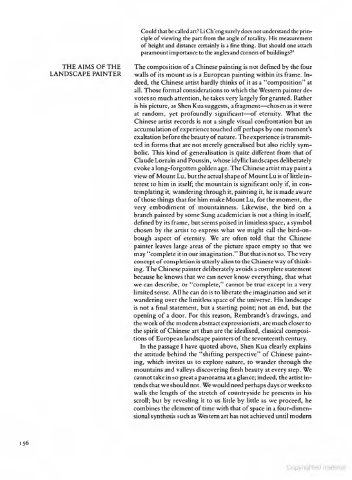Page 176 - The Arts of China, By Michael Sullivan Good Book
P. 176
Could that be called art? Li Ch'eng surely docs not understand the prin-
ciple of viewing the part from the angle of totality. His measurement
of height and distance certainly is a fine thing. But should one attach
paramount importance to the angles and corners of buildings?'
THE AIMS OF THE The composition of a Chinese painting is not defined by the four
LANDSCAPE PAINTER walls of its mount as is a European painting within its frame. In-
deed, the Chinese artist hardly thinks of it as a "composition" at
all. Those formal considerations to which the Western painter de-
votes so much attention, he takes very largely for granted. Rather
is his picture, as Shcn Kua suggests, a fragment—chosen as it were
at random, yet profoundly significant—of eternity. What the
Chinese artist records is not a single visual confrontation but an
accumulation of experience touched off perhaps by one moments
exaltation before the beauty of nature. The experience is transmit-
ted in forms that arc not merely generalised but also richly sym-
bolic. This kind of generalisation is quite different from that of
Claude Lorrain and Poussin, whose idyllic landscapes deliberately
evoke a long-forgotten golden age. The Chinese artist may paint a
view of Mount Lu, but the actual shape of Mount Lu is of little in-
terest to him in itself; the mountain is significant only if, in con-
templating it, wandering through it, painting it, he is made aware
of those things that for him make Mount Lu, for the moment, the
very embodiment of mountainness. Likewise, the bird on a
branch painted by some Sung academician is not a thing in itself,
defined by its frame, but seems poised in limitless space, a symbol
chosen by the artist to express what we might call the bird-on-
bough aspect of eternity. We are often told that the Chinese
painter leaves large areas of the picture space empty so that we
may "complete it in our imagination." But that is not so. The very
concept ofcompletion is utterly alien to the Chinese way of think-
ing. The Chinese painter deliberately avoids a complete statement
because he knows that we can never know everything, that what
we can describe, or "complete," cannot be true except in a very
limited sense. All he can do is to liberate the imagination and set it
wandering over the limitless space of the universe. His landscape
is not a final statement, but a starting point; not an end, but the
opening of a door. For this reason, Rembrandt's drawings, and
the work of the modern abstract expressionists, arc much closer to
the spirit of Chinese art than are the idealised, classical composi-
tions of European landscape painters of the seventeenth century.
In the passage I have quoted above, Shen Kua clearly explains
the attitude behind the "shifting perspective" of Chinese paint-
ing, which invites us to explore nature, to wander through the
mountains and valleys discovering fresh beauty at every step. We
cannot take in so great a panorama at a glance; indeed, the artist in-
tends that we should not. We would need perhaps days or weeks to
walk the length of the stretch of countryside he presents in his
scroll; but by revealing it to us little by little as we proceed, he
combines the clement of time with that of space in a four-dimen-
sional synthesis such as Western art has not achieved until modern
156
Copyrighted material

